
Macular degeneration is the leading cause of irreversible blindness in Americans age 50 and older.1,2
The risk of contracting macular degeneration is reduced in those ingesting higher amounts of certain plantcarotenoids. These carotenoids also delay early-stage macular degeneration from worsening.
What’s missing has been an effective strategy for countering typical forms of vision loss that impact all maturing individuals.1,3
That limitation is about to change.
Recent clinical studies show vision-enhancing benefits using extracts from a flower-derived spice called saffron.
Scientists first discovered that saffron can improve visual acuity as well as sensitivity to light, even in people withearly macular degeneration.4-6 More impressively, patients experienced improvement in vision that was measured by them seeing an average of two additional lines on the eye chart commonly used by physicians to test vision.6
In another recent finding, people with the highest intake of alpha-carotene had a 32% lower risk for developingadvanced age-related macular degeneration.7
By supplementing with saffron extracts and alpha-carotene—in addition to other nutrients recognized for their ability to protect retinal structures—we can actively protect our eyesight before symptoms of visual loss appear.4-7
Natural Sunglasses for the Eyes
Up to 11 million people in the United States have at least some degree of age-related macular degeneration.2,8 While2% of 50 to 59 year olds suffer from the disease, that number surges to 30% in those over 75 years.2
The macula, the small spot at the center of the retina, is particularly rich in light-sensing cells, which are essential for our ability to sharply see things that are directly in front of us.1 Because of its yellow color, the macula absorbs excess blue and ultraviolet light in order to prevent their destructive effects on light-sensing cells.9-11 Think of it as protective sunglasses for the retina.
Age-related macular degeneration occurs in response to prolonged exposure of the eye to visible and ultraviolet light, as well as chemical stresses from a glucose- and oxygen-rich blood supply. Over time, these factors all contribute to the breakdown of our retinal light-sensing cells.
As degeneration of cells in the macula progresses, victims lose their central vision and become less able to see what they are trying to focus on.1,12 Consequently, the ability to read, drive, do intricate work, and perform many other daily tasks can become impaired, even before the onset of legal blindness.
It is important to protect the structural integrity of the macula early in order to prevent it from degenerating to its more advanced stages.
Saffron Benefits Early Age-Related Macular Degeneration
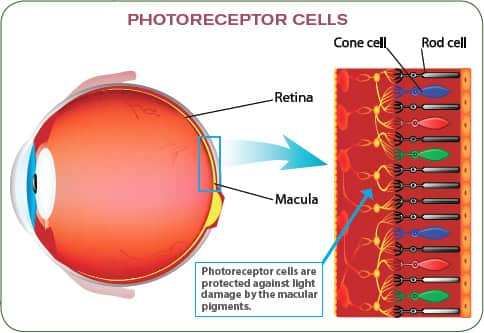
Saffron is a culinary spice derived from parts of the crocus (Crocus sativus) flower. Newly published scientific studies demonstrate its ability to improve visual acuity and to improve sensitivity of the retina to light in people with early macular degeneration. 4-6
Saffron protects and prevents the steady breakdown of light-sensitive cells in the center of the retina, the macula. This addresses the root cause of age-related macular degeneration and improves light sensitivity, a major manifestation of the disease.
In the first study, patients with early age-related macular degeneration were randomly assigned to receive either 20 mgper day of saffron or a placebo.
During the supplement phase, patients had stronger electrical responses to light overall.4 Researchers were able to determine these improvements by using sophisticated testing that measures the electrical output of retinal cells in response to light stimulation. If these tests show relatively poor responses to light, it is an indicator of ailing retinal cells.13
The patients also had a better response to dim light during the supplement phase (meaning that their eyes were more sensitive to dim light images). No such changes were apparent during the placebo phase. This means that saffronsupplementation improved the light-sensing abilities of retinal cells in early age-related macular degeneration.4 This is an unprecedented finding.
In a second observation of this study, subjects who took saffron had a significant increase in visual acuity, a term that refers to the sharpness of vision at a distance. After three months of supplementation, patients had an average increase in visual acuity at a distance of one full line (14.3% better than baseline) on the familiar Snellen vision chart which measures visual acuity at a distance of 20 feet.4 That means, for example, that someone whose visual acuity at a distance was 20/40 prior to supplementation would see with 20/30 vision afterwards. Once again, no improvement in distance vision was seen in placebo recipients.
These findings were replicated after three months, when the supplement/placebo treatments were reassigned and then continued for another three months.4 This suggests consistency and reproducibility of benefit for the dietary supplement with improving visual acuity at a distance.
Longer-Term Benefits of Saffron
While these initial observations demonstrated meaningful and rapid visual improvements, scientists wanted to see if saffron could produce more long-term effects. That’s why, in a follow-up study, the same researchers examined saffron supplementation (20 mg per day) in subjects with early macular degeneration over an average treatment period of 14 months.6
In a similar finding to the first study, retinal sensitivity to light increased significantly by the end of three months—and impressively, it remained elevated for the entire course of the study. Even more impressive, the average visual acuity improved by not one, but two lines on the Snellen chart.6 This shows us that longer supplementation periods produce further vision improvement.
A third human study confirms the previous findings and demonstrates nearly identical improvements in retinal light sensitivity over an average 11-month period. This study went a step further because it determined that saffron produces improvements in early age-related macular degeneration regardless of one’s heredity.5 This is important because it means that the results of these studies can be generalized to all adults with early age-related macular degeneration, not just those with specific genetic risk factors.
WHAT YOU NEED TO KNOW
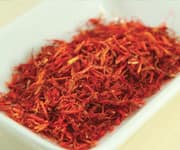 |
Saffron Protects against Vision Loss
- Age-related macular degeneration (AMD) threatens all Americans with eventual vision loss and even blindness.
- To date, only advanced age-related macular degeneration has proved amenable to treatment, while prevention efforts have failed to slow the disease in its earliest stages, before substantial retinal damage has occurred.
- New studies reveal that saffron can enhance retinal responses and sensitivity to light and significantly improve visual acuity in people with early age-related macular degeneration.
- Saffron’s benefits can be augmented by other proven vision-preserving nutrients, including alpha-carotene, lutein, zeaxanthin, and astaxanthin, as well as cyanidin-3-glucoside, which preserves dim-light vision.
- Together, these nutrients appear applicable to all people 50 years and older, offering protection against age-related macular degeneration at its earliest stages.
Reducing Risk of Advanced Age-Related Macular Degeneration
Alpha-carotene is another yellow pigment that offers a complement to saffron. Similar to saffron’s key components,alpha-carotene is a carotenoid that protects the pigmented cells of the retina from light-induced oxidative damage. People who consume the most dietary alpha-carotene have a 32% reduced risk for developing advanced age-related macular degeneration compared to those with the lowest consumption.7
This was demonstrated in the Nurses’ Health Study and Health Professionals Follow-Up Study, which analyzed data from 63,443 women and 38,603 men 50 years old or older. These findings make it clear that alpha-carotene may be the perfect complement to saffron’s ability to improve retinal function in early age-related macular degeneration.7
THE STAGES OF AGE-RELATED MACULAR DEGENERATION
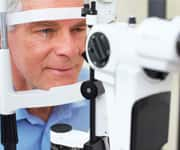 |
Macular degeneration is characterized by drusen, yellowish deposits of fat and protein beneath the retina that can only be seen in an examination conducted by a skilled vision professional. Small numbers of drusen appear to be a natural part of aging, but larger numbers, especially of medium to large drusen, suggest age-related macular degeneration.1,39
In early age-related macular degeneration, drusen are of medium size and rarely produce symptoms.
In intermediate macular degeneration, drusen are larger and dark clumps of pigment from broken-down retinal cells may appear on an eye examination. Again, even at this intermediate stage of retinal changes, symptoms are usually absent.
Late age-related macular degeneration is signaled by the appearance of visual symptoms, including blurring in the center of the visual field, blank spots in vision, and an apparent dimming of objects.
Late age-related macular degeneration has two forms, known as dry and wet (or neovascular) degeneration.1,39
Dry age-related macular degeneration is by far the most common type, affecting 90% of those with the condition. People with this form of the disease continue to have progression and growth of retinal drusen and a gradual breakdown of retinal light-sensing cells, eventually leading to vision loss.1,39
Wet age-related macular degeneration only occurs in about 10% of people with the condition, but it accounts for about 90% of cases of blindness. Wet age-related macular degeneration is defined by the presence of tiny new blood vessels growing in the tissue layer beneath the retina, which can leak to produce swelling and damage to the macula itself. Wet age-related macular degeneration tends to progress rapidly and to greater severity than the dry form and is much likelier to produce severe vision loss.1,39
Additional Nutrients for Eye Health
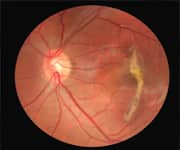
Lutein and zeaxanthin are found in high concentrations in several components of the eye, including the lens, the retina, and the sensitive macula.14,15
As with saffron and alpha-carotene, lutein and zeaxanthin are yellow pigments that efficiently absorb higher-energy (blue and ultraviolet) light, preventing it from damaging retinal tissues. As an added benefit, lutein and zeaxanthin scavenge oxygen free radicals and reduce their damaging impact on retinal cells.14-17
Studies of adults with age-related macular degeneration show that supplementing with10 to 12 mg of lutein per day raises the density of protective pigmented cells in the retina by up to 175% compared with patients taking placebo.18,19 This means that it enhances the eye’s own ability to protect against damaging blue and ultraviolet light. It is important to note that lower doses, such as 6 mg per day, have proved insufficient to significantly improve pigment density, and have only borderline effects on vision.20
In patients with early age-related macular degeneration, 48 weeks of supplementation with lutein at 10 or 20 mgalone (or at 10 mg in combination with zeaxanthin) produced significant increases in electroretinogram signals. This is a measure of the power of light-sensitive cells to produce electrical impulses after stimulation by light.21
Multiple large clinical studies have now demonstrated that supplementation with lutein and/or zeaxanthin can improve retinal function, increase the ability to see contrasting colors and shapes, and improve visual acuity.19,21-24
CAN ALPHA-CAROTENE PREVENT PREMATURE DEATH?
 |
Alpha-carotene is getting a lot of attention as a vision-enhancing, retinal-protecting supplement. Recent studies, however, suggest another intriguing—and potentially ground-breaking—effect of alpha-carotene in the blood: prolonging life. There is now good support for a mechanism by which it could do so.
Large-scale studies have shown a significant association between serum levels of the carotenoid alpha-carotene and the risk of dying. In a study of more than 15,000 people, individuals with the highest alpha-carotene levels were 39% less likely to die from all causes compared to those with the lowest levels.40
A 2016 study suggests one possible reason for this longevity-promoting feature of alpha-carotene: preventing the shortening of telomeres, which are the stretches of DNA at the ends of chromosomes that are associated with aging. Shorter telomeres are associated with more advanced aging.
In a study of more than 3,600 people, those with higher levels of alpha-carotene and other carotenoid pigments in their blood had longer telomeres. Indeed, a doubling in blood alpha- and beta-carotene and beta-cryptoxanthin was associated with 2% longer telomeres, and those with the highest levels had telomeres 5% to 8% longer than those with the lowest levels.41
Thus, a high intake of alpha-carotene and other carotenoid pigments could help aging individuals achieve a longer life through slowing telomere shortening.
Protect against Night-Blindness
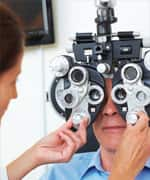
Cyanidin-3-glucoside (C3G) is a flavonoid compound found in many berries25,26 that is particularly beneficial for night vision.
That’s because cyanidin-3-glucoside enhances both the quality and function of rhodopsin, a light-sensitive protein found in the rod cells of the retina.26-29 Rod cells are the eye’s most sensitive cells and they allow us to see in very dim light. Loss of rod cells is associated with night-blindness or reduced vision in dim light.30
Cyanidin-3-glucoside hastens the ability of rhodopsin to regenerate.28,29
It is this rapid regeneration of rhodopsin that has vision scientists excited about its potential benefits to enhance night vision.
A study of healthy volunteers showed that just 50 mg of a berry extract concentrate containing cyanidin-3-glucosideallowed aging individuals to see better in darkness after 30 minutes.31
Protect against Retinal Cell Death
Astaxanthin is a reddish carotenoid molecule derived from marine algae. It has powerful free radical scavenging and anti-apoptotic properties that help protect retinal cells from death induced by chemical and physical stresses.32-34
Astaxanthin has been found to prevent the vision-damaging effects of wet macular degeneration and can also prevent cell damage related to increased pressure in the eye (glaucoma).32,35,36
Astaxanthin could be especially beneficial for diabetics. Eighty percent of people who have had diabetes for more than 10 years suffer from diabetic retinopathy, a condition that occurs when high blood sugar concentrations cause progressive damage to the retina. Studies in mice have demonstrated that astaxanthin prevents the early cell death in retinal nerve cells that results from high blood sugar concentrations.33
Two human studies have shown that the combination of astaxanthin, lutein, and zeaxanthin led to significant improvements in visual acuity in supplemented patients compared with untreated patients.37,38
Summary
Macular degeneration threatens every American over 50 with vision loss.
Certain carotenoids have been shown to help prevent this condition and delay progression in its intermediate to advanced (blinding) stages. The dilemma up until now was how to protect against so-called “normal” loss of visual acuity that occurs with aging.
New human studies indicate that supplementing with saffron can, for the first time, produce meaningful changes in the retina and improve visual acuity, even in people with early macular degeneration. This knowledge should allow everyone to protect their vision before symptoms appear, and before significant breakdown of retinal light-sensing cells occurs.
Saffron and alpha-carotene are now available in combination with other vision-protecting nutrients, including lutein,zeaxanthin (and their related compounds), and astaxanthin. These plant pigments powerfully absorb blue and ultraviolet light, which are the most damaging to retinal cells. The addition of cyanidin-3-glucoside helps protect against night blindness and reduced vision in dim light.
Widespread use of these plant-derived extracts could have enormous public health implications in providing meaningful ocular support as populations move into older age.

